Augmentation
We did not implement the image augmentation feature within WordCanvas because we consider it a highly "customized" requirement. Different use cases may require different augmentation methods. However, we provide some simple examples to demonstrate how the image augmentation process can be implemented.
We typically use the albumentations library for image augmentation, but you are free to use any library of your choice.
After albumentations was updated to v2.0.0, many operation parameter names have changed. Please be aware of this.
For more details, refer to: albumentations v2.0.0
Example 1: Shear Transformation
After generating the text image, apply custom operations.
Here, we demonstrate applying a shear transformation using Shear:
The Shear class is responsible for applying a shear transformation to the image. Shearing alters the geometric shape of the image, creating a horizontal tilt, which can help the model learn to recognize objects at different angles and positions.
-
Parameters
- max_shear_left: Maximum shear angle to the left. The default is 20 degrees.
- max_shear_right: Maximum shear angle to the right. The default is also 20 degrees.
- p: Probability of applying the operation. The default is 0.5, meaning there’s a 50% chance that any given image will be sheared.
-
Usage
from wordcanvas import Shear, WordCanvas
gen = WordCanvas()
shear = Shear(max_shear_left=20, max_shear_right=20, p=0.5)
img = gen('Hello, World!')
img = shear(img)
Example 2: Rotation Transformation
To implement rotation transformation, we import the SafeRotate class from albumentations.
When using operations like Shift, Scale, or Rotate, issues related to background color filling may arise.
In this case, you should call infos to obtain the background color.
import cv2
from wordcanvas import ExampleAug, WordCanvas
import albumentations as A
gen = WordCanvas(
background_color=(255, 255, 0),
text_color=(0, 0, 0),
return_infos=True
)
img, infos = gen('Hello, World!')
aug = A.SafeRotate(
limit=30,
border_mode=cv2.BORDER_CONSTANT,
fill=infos['background_color'],
p=1
)
img = aug(image=img)['image']

Example 3: Modify Class Behavior
At this point in the code, you might notice:
- If each image generated has a random background color, then
albumentationsneeds to be reinitialized every time, which doesn’t seem efficient.
Perhaps we can modify the behavior of albumentations so that it only needs to be initialized once and can be reused?
import albumentations as A
import cv2
import numpy as np
from wordcanvas import RandomWordCanvas
gen = RandomWordCanvas(
random_background_color=True,
return_infos=True
)
aug = A.SafeRotate(
limit=30,
border_mode=cv2.BORDER_CONSTANT,
p=1
)
imgs = []
for _ in range(8):
img, infos = gen('Hello, World!')
# Modify albu class behavior
aug.fill = infos['background_color']
img = aug(image=img)['image']
imgs.append(img)
# Display results
img = np.concatenate(imgs, axis=0)

We still recommend using the method from Example 2 (even though it may seem inefficient), as modifying albumentations' class behavior could cause issues in multi-threaded training environments. Please be cautious!
Example 4: Adding Background
If you’re not satisfied with a simple text image and want to add a background to enhance the model's generalization ability, you will need to prepare a set of background images and follow the example below:
import albumentations as A
import cv2
import numpy as np
from wordcanvas import RandomWordCanvas
from albumentations import RandomCrop
gen = RandomWordCanvas(
random_text_color=True,
random_background_color=True,
return_infos=True
)
# Generate a random text image
img, infos = gen('Hello, World!')
Then, load a background image:
bg = cv2.imread('path/to/your/background.jpg')
Finally, crop a random region from the background and place the text image on top:
bg = RandomCrop(img.shape[0], img.shape[1])(image=bg)['image']
result_img = np.where(img == infos['background_color'], bg, img)

Example 5: Perspective Transformation
Perspective transformation projects an image onto a new viewplane. This type of transformation can simulate how objects appear from different angles and distances.
We continue with the previous example and apply a perspective transformation to the image before adding the background:
from albumentations import Perspective
aug = A.Perspective(
keep_size=True,
fit_output=True,
fill=infos['background_color'],
)
img = aug(image=img)['image']
result_img = np.where(img == infos['background_color'], bg, img)

For "spatial transformation" augmentation operations, we recommend performing the perspective transformation first, followed by adding the background image. This ensures that the background won’t have strange black edges.
Example 6: Sun Flare
Text images often have issues with strong light reflections. In this case, we can use RandomSunFlare to simulate this effect:
from albumentations import RandomSunFlare
aug = A.RandomSunFlare(
src_radius=128,
src_color=(255, 255, 255),
)
result_img = aug(image=result_img)['image']

For "pixel modification" augmentation operations, we recommend adding the background image first and then applying the image transformation. This prevents background information from being lost, which could result in random noise.
Conclusion
This concludes the introduction to the project. If you have any questions or suggestions, feel free to leave a comment below, and we will reply as soon as possible.
If you’re unsure how to implement a certain operation, you are also welcome to leave a comment. We will do our best to assist you.
Enjoy using it!
